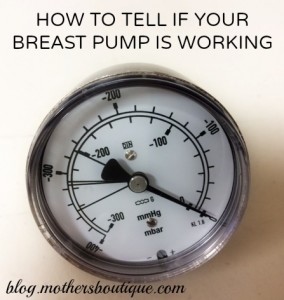When I was pumping for my second son (milk he never did agree to drink from a bottle!), I noticed my output decreasing when he turned six months old. I worried I was having issues letting down for the pump as I had with my first child and never paused to think it might be the pump itself malfunctioning.
I soon learned that pump motors sometimes lose strength and that the pump parts can drastically affect pump efficiency. Here at A Mother’s Boutique, Judy has a device she can use to test your pump and help you figure out whether it’s working effectively.
To test the pump, Judy first sets up the flanges and tubes and bottles. The testing device has gauge with a rubber stopper to plug one flange and the gauge itself plugs into the other, as if the pump were connected to two breasts.
She then turns the pump on full blast and measures the suction strength–an Ameda pump should produce a reading of at least 200 millimeters mercury.
If a reading is below this number, Judy first turns to the pump parts.
“Just like you get the oil changed on your car regularly,” she says, “you should change your pump parts every 3 months or so.”
The tubing on the pump should fit very snugly to the pump motor and to the flanges. You should struggle a bit to pull it on and off!
Likewise, the valves (plus white flappy bits on a Medela) should fit very snugly to the flange. Again, it should take a bit of effort to slide them on and off. These two seemingly-small things (valves and tubes) can have a drastic effect on the milk output.
Just as an example, Ameda has recently updated their valves. Using the testing device, we noticed at least 25 mmHg increased efficiency with the updated valves. That’s about a 15% increase just for the valves! As moms wash and use their pump parts, the tight fit gradually loosens with time. So, if you see your output dip, your first move should be buying replacement pump parts!
If new parts don’t affect the reading on the device, that means the pump motor itself is defective. In this case, provided the pump is less than a year old, the manufacturer should replace it at no cost to the user. Several breast pump manufacturer websites indicate that a pump “might” get a mother through two babies, but the motor might show decreased speed and suction after a year. If you’re using an older pump, or have pumped for multiple children, you might be experiencing a slow motor.
Local moms are able to bring their breastpump into the boutique for testing (note that there is a $10 fee for this service if the pump was purchased elsewhere, but this fee can be applied toward the purchase of a new pump). Non-local moms can likely get their pump tested in any small shop that sells breastpumps. A box store is unlikely to have this service, but some pediatricians with a lactation consultant on staff are able to test breastpumps as well.
As for me, I received a new pump when, even with new parts, my pump efficiency did not improve. The replacement process was easy–just a phone call to my insurance company–and the replacement pump performed as it should have.
Have you noticed a change in your breast pump output? Leave us a comment to share your solutions!











[…] A good breast pump should generate between 220-275 mmHg suction. We are able to test your pump motor efficiency in our shop locally–most small businesses selling breast pumps should be able to test your […]